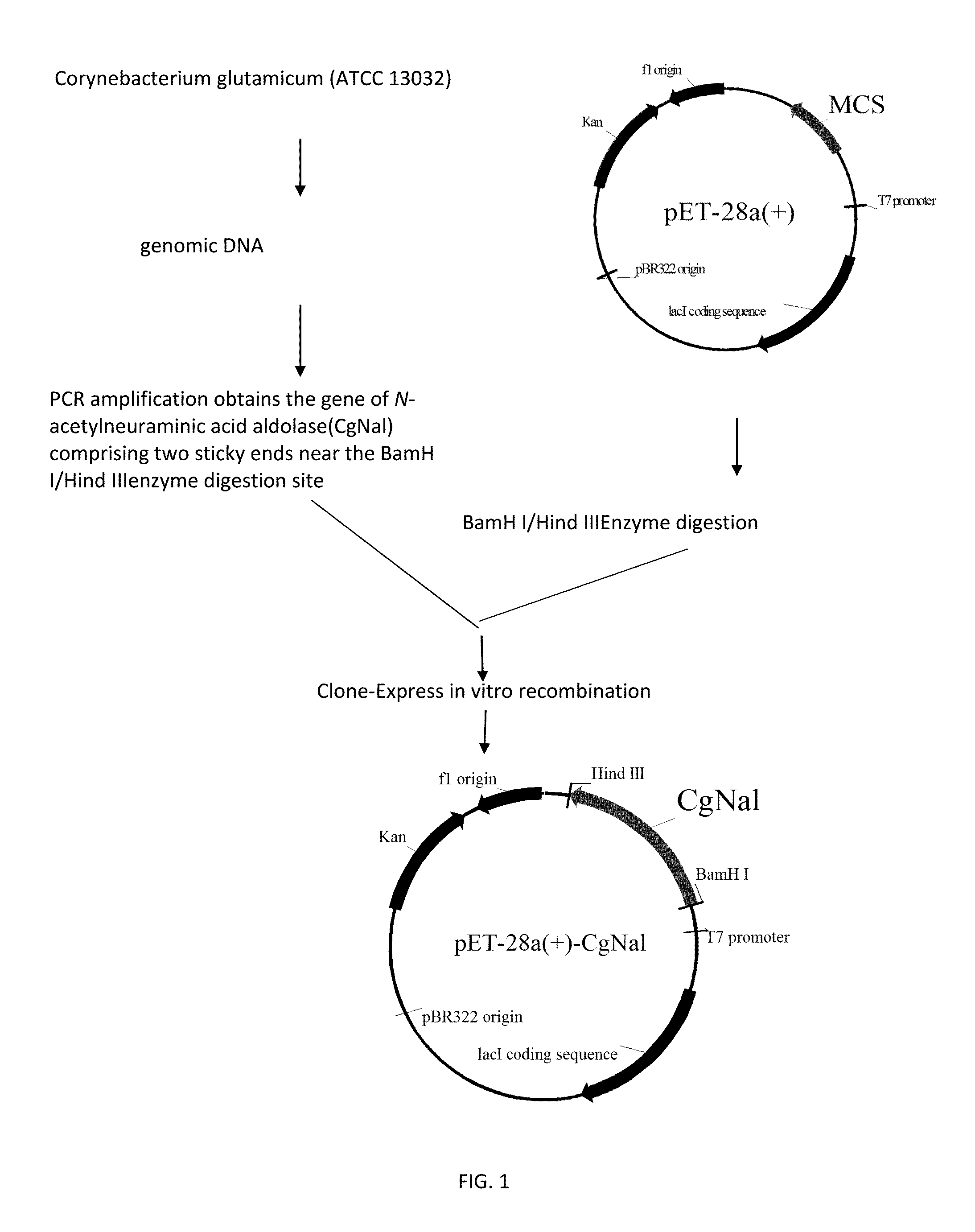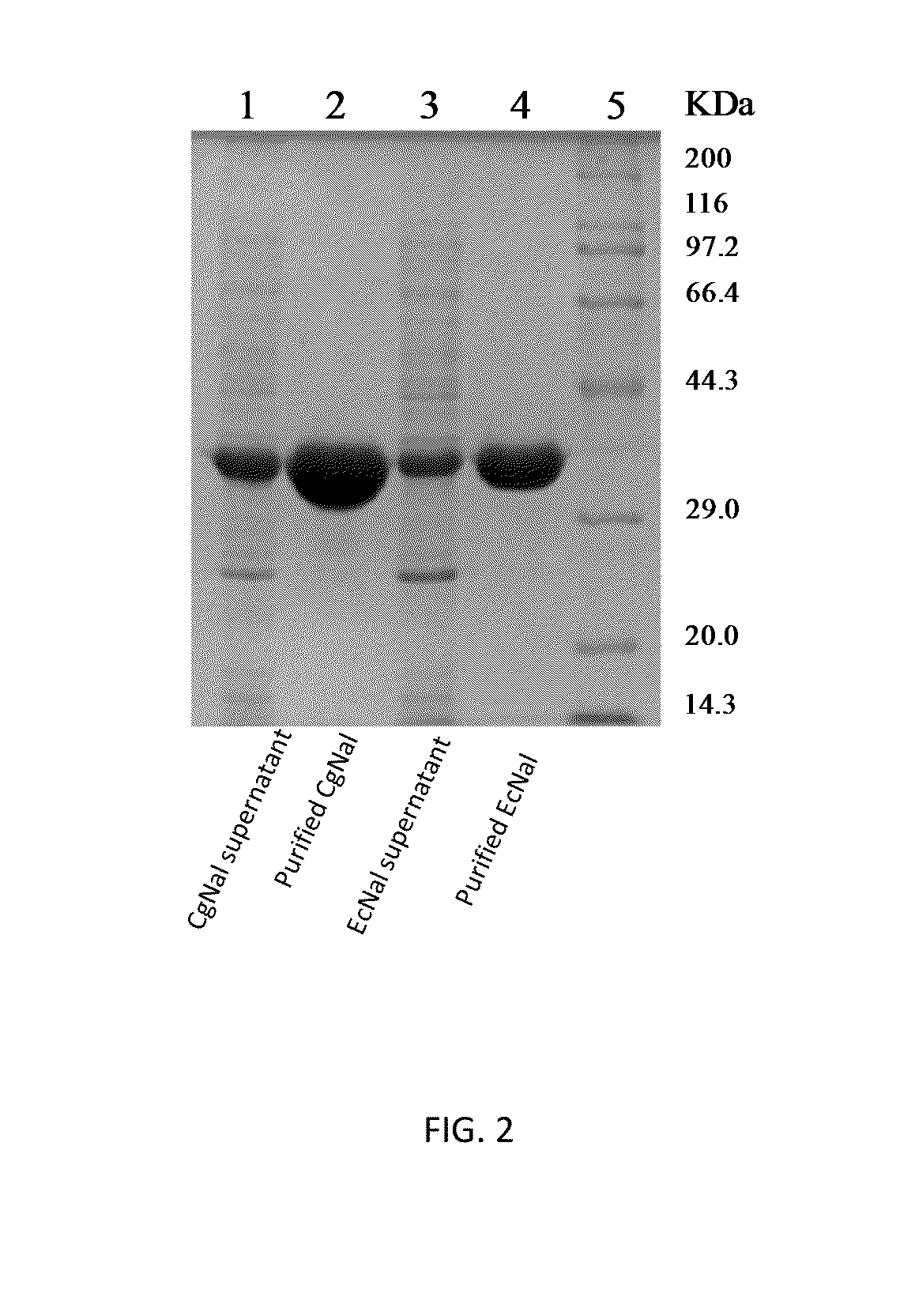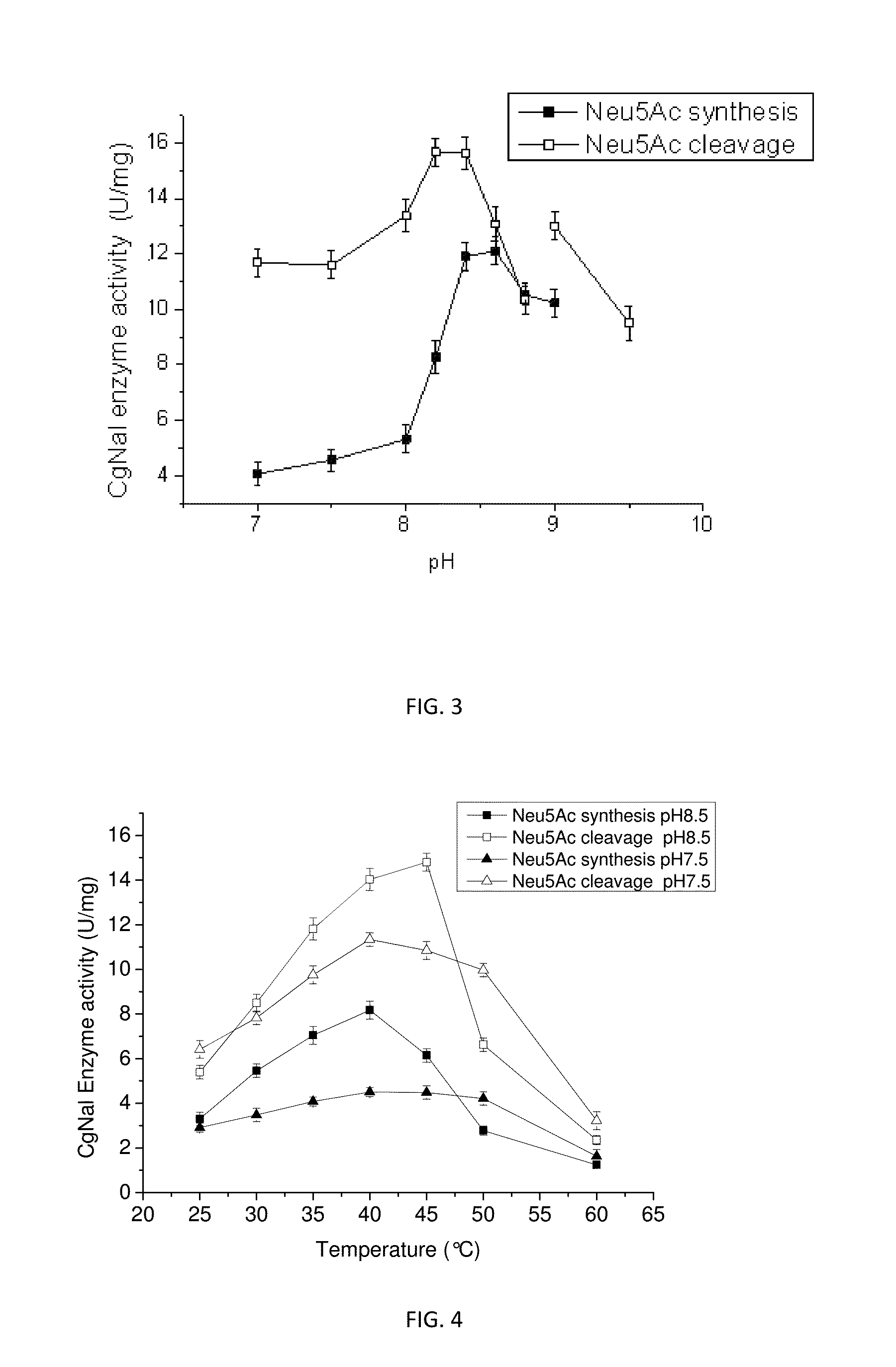Use of n-acetylneuraminic acid aldolase in catalytic synthesis of n-acetylneuraminic acid
a technology of n-acetylneuraminic acid and catalytic synthesis, which is applied in the field of biotechnology, can solve the problems of nal all having a common and nal is more prone to decomposition, and achieve good effects
- Summary
- Abstract
- Description
- Claims
- Application Information
AI Technical Summary
Benefits of technology
Problems solved by technology
Method used
Image
Examples
example 1
Establishing the Recombinant E. coli Rosseta (pET28a-CgNal)
1. Obtaining N-Acetylneuraminic Acid Aldolase Gene:
[0024]The genome of Corynebacterium glutamicum ATCC 13032 was extracted, then PCR was carried out by using the extracted genome as the template.
[0025]The primer adding enzyme digestion site used in expression vector was established, the sequence of the primer was as follow:
An upstream primer (CgNal-sense comprising BamH I) is:(SEQ ID NO: 3)5′-GACAGCAAATGGGTCGCGGATCCATGGCTTCCGCAACTTTCACCG-3′A downstream primer (CgNal-anti comprising HindIII) is:(SEQ ID NO: 4)5′-TGCTCGAGTGCGGCCGCAAGCTTTTAAGCGGTGTACAGGAATTCATC-3′
[0026]All the primers were synthesized by Suzhou GENEWIZ Corporation.
PCR Conditions for Gene:
[0027]Cycle 30 times according to the following parameters: denaturation at 98° C. for 10 seconds, annealing and extension at 68° C. for 1 minute, finally extension at 72° C. for 10 minutes.
2. Transforming the Recombinant E. coli Rosseta (DE3):
[0028]The pET-28a vector (pET-28a, ...
example 2
Obtaining the Aldolase CgNal
1. Expression of N-Acetylneuraminic Acid Aldolase CgNal.
[0029]The recombinant strain E. coli Rosseta (pET-28a-CgNal) was picked up into a LB liquid medium containing antibiotics, incubated under vibration at 37° C. overnight. Then, inoculated to a fresh culture solution in a 1 (v / v) % inoculation amount, when incubated to OD600 of about 0.6 at 37° C., IPTG was added to a final concentration of 0.2 mmol·L−1, centrifuged at 200 rpm at 30° C., induced expression for 10 hours, then centrifuged (4° C., 10000 rpm, 10 minutes).
2. Purifying N-Acetylneuraminic Acid Aldolase CgNal.
[0030]The collected bacterial sludge was re-suspended in a 100 mmol·L−1 Tris-HCl (PH 7.5) buffer, and the cells were ultrasonically lysed (power 300W, sonicated for 3 seconds, interrupted for 5 seconds, totally 5 minutes), centrifuged (4° C., 12000 rpm, 15 minutes), and supernatant was removed.
[0031]The collected enzyme supernatant was added to a Ni-NTA column (Ni-NTA His Bind Resin, Nova...
example 3
Study on the Enzymatic Properties of the Aldolase CgNal
1. Detecting Method for CgNal Enzyme Activities
[0032]The enzyme activities of CgNal were divided into the enzyme activity of Neu5Ac synthesis reaction and the enzyme activity of Neu5Ac decomposition reaction. The enzyme activity on Neu5Ac synthesis reaction was defined as the enzyme amount required for synthesizing 1 μmol Neu5Ac per minute, and the enzyme activity on Neu5Ac decomposition reaction was defined as the enzyme amount required for decomposing 1 μmol Neu5Ac per minute, the enzyme activity detection solution for Neu5Ac decomposition reaction was 0.1 M pyruvic acid, 0.1 mol·L−1ManNAc and 0.1 mol·L−1 Tris-HCl (pH 7.5 or 8.5); the enzyme activity detection solution for Neu5Ac decomposition reaction was 100 mmol·L−1 Neu5Ac and 0.1 mol. L−1 Tris-HCl (pH 7.5 or 8.5). The purified Nal was added into 1 ml of enzyme activity detection solution to the final concentration of 30 μg / ml (about 0.36 U / ml). After reaction at 37 V for 2...
PUM
| Property | Measurement | Unit |
|---|---|---|
| Temperature | aaaaa | aaaaa |
| Temperature | aaaaa | aaaaa |
| Time | aaaaa | aaaaa |
Abstract
Description
Claims
Application Information
 Login to View More
Login to View More - R&D
- Intellectual Property
- Life Sciences
- Materials
- Tech Scout
- Unparalleled Data Quality
- Higher Quality Content
- 60% Fewer Hallucinations
Browse by: Latest US Patents, China's latest patents, Technical Efficacy Thesaurus, Application Domain, Technology Topic, Popular Technical Reports.
© 2025 PatSnap. All rights reserved.Legal|Privacy policy|Modern Slavery Act Transparency Statement|Sitemap|About US| Contact US: help@patsnap.com



